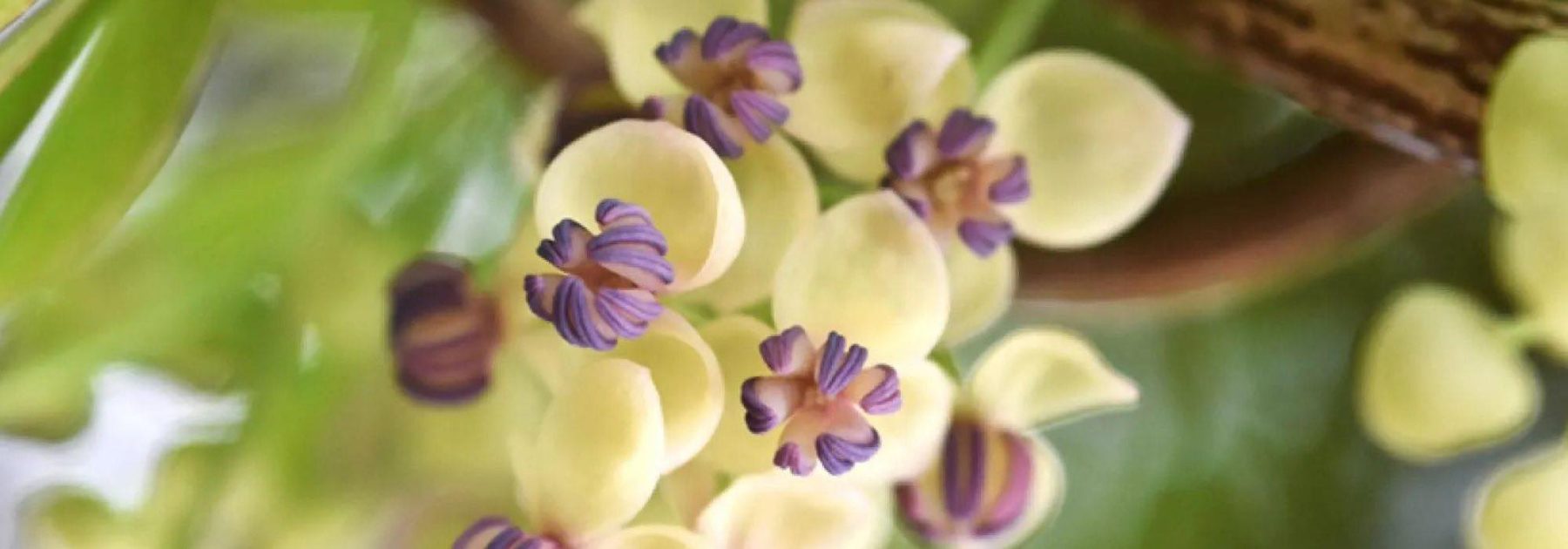
Late Spring Climbing Plants: For a Garden That Heralds Summer!
Advantages, characteristics, and guide to successfully adopting them in the garden or in pots
Contents
Climbing plants are garden essentials, thanks to their incredible versatility. Stunning blooms, ornamental foliage, interesting fruit production… these are just some of the benefits they offer. They can brighten up a large part of the year, especially during the transitional period of late spring. Let’s explore the advantages of these late spring-flowering climbers and how to choose them.
Why You Shouldn't Overlook Late Spring Blooming Plants
The days are getting longer, the sun is more present, and even the cooler regions have been able to start planting less hardy plants and bring out the potted plants that dislike the cold: spring is well and truly here.
One of the keys to having a beautiful garden all year round is to stagger the flowering periods. This keeps the space constantly evolving, renewing itself in a true botanical spectacle. At the start of spring, many plants will already be in full swing: bulbs, shrubs, or early-flowering perennials. In summer, new ones will take over. But late spring can sometimes be a transitional period, where some plants have stopped flowering while others haven’t yet started. Yet, between late May and late June, many of us love spending time outdoors, enjoying the beautiful days before the summer heat sets in. It would be a shame not to take the opportunity to admire the garden, terrace, or balcony during this sometimes quieter period.
Why Choose Climbing Plants to Brighten Up This Period?
Growing climbing plants is a natural and aesthetic solution for covering various structures in the garden. They can indeed dress up an unsightly wall, enhance a pergola, provide shade on a terrace, or spread across the ground to create a lush carpet of greenery.
At the same time, they are often very beneficial for biodiversity, offering shelter and food for many small creatures: birds, insects, small mammals, and more.
In permaculture, they are valued for exploiting vertical space, allowing for denser planting. Taking up little ground space, they are ideal for creating layers of different heights that would otherwise be difficult to utilise. All while providing useful shade and coolness to neighbouring plants.
Moreover, these are generally easy-to-grow plants that require minimal maintenance.
To top it off, they offer a beautiful diversity of colours, foliage, and shapes.
Late spring climbers pair well with:
- late-flowering bulbs (Alliums, Dutch Iris, late tulips, Foxtail Lilies…);
- spring-flowering shrubs (Mexican Orange Blossom, rhododendrons, weigelas, lilacs, mock oranges, ceanothus, deutzias, some spireas…);
- perennials (columbines, spurges, bleeding hearts, Oriental poppies, certain hardy geraniums, Japanese primrose, peonies…);
- etc.
Late Spring Climbing Plants: A Variety of Colours
White, yellow, pink, purple, mauve, blue, bicolour… Late spring climbing plants offer a beautiful variety of flower colours, catering to all tastes and garden styles.
If you love pastel shades and romantic atmospheres, wisterias are, of course, the perfect candidates to brighten up late spring. For pink flowers, choose, for example, the Japanese wisteria Wisteria floribunda ‘Honbeni’ or the Wisteria venusta ‘Rosea’. For white blooms, opt for the Wisteria floribunda ‘Alba’ or the Wisteria brachybotrys ‘White Silk’. Do you prefer purple flowers? Turn to the Wisteria frutescens ‘Longwood Purple’ or the Wisteria floribunda ‘Domino’.
Clematis are also among the queens of late spring, particularly the Clematis x patens ‘Miss Bateman’, which graces us with hundreds of white flowers with red stamens around May. For softer shades, consider the Clematis montana ‘Tetrarose’, which produces a multitude of pink to lilac flowers. Meanwhile, the Clematis atragene ‘Country Rose’ delights with slightly ruffled flowers in a delicate soft pink.
To highlight the transitional period between spring and summer, you can also choose to evolve the colour palette in your garden: after winter, fresh and soft colours took centre stage. Just before summer, why not be tempted by more intense shades? To herald the arrival of this season, you could, for example, opt for warmer colours, such as with the Banks’ rose ‘Lutea’, a beautiful giant that produces fully double flowers in a rich butter-yellow. Make sure to provide ample space and a sturdy support for its 12-metre height.
Also worth mentioning is the bicolour bloom of the Akebia quinata ‘Cream Form’, which produces clusters of small cream flowers with pink and purple centres between April and May.
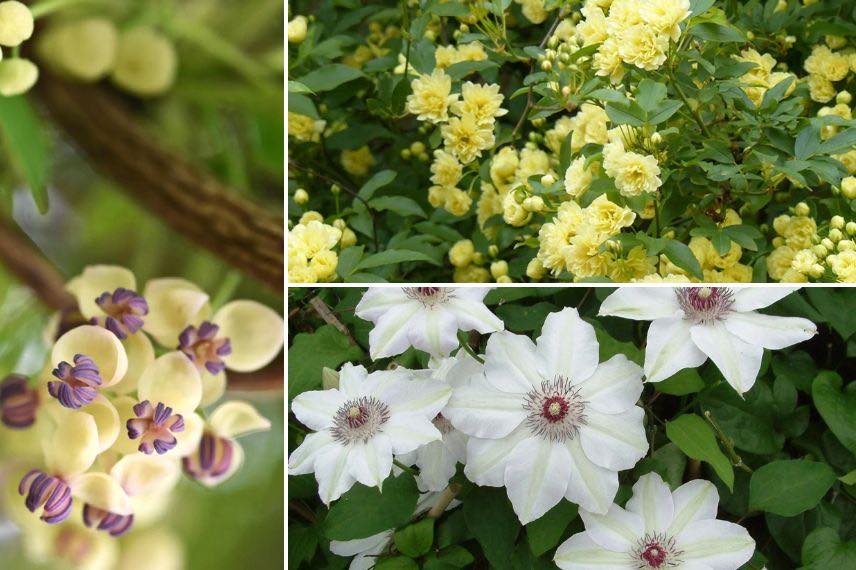
Akebia quinata ‘Cream Form’, Rosa banksiae ‘Lutea’, Clematis ‘Miss Bateman’
Climbing Plants with Fragrant Late Spring Blooms
To bring life to your garden, you can play with colours, textures, shapes, and even scents. Among late spring-flowering climbers, consider the Clematis montana ‘Starlet White Perfume’. From April to June, it produces large, double white flowers that emit a delicate floral fragrance. For a truly intense scent, opt for the Clematis ‘Sugar Sweet® Scented Clem’, whose blooms evoke the scent of acacia. Meanwhile, ‘Double Delight’ releases sweet notes of vanilla and chocolate.
It’s impossible not to mention wisterias again here, such as the Wisteria sinensis ‘Caroline’, whose blue-mauve flower clusters are particularly fragrant, exuding very floral, sweet, and smooth notes. Also worth mentioning are ‘Blue Line’ or ‘Prolific’, prized for their beautifully scented late spring blooms.
The five-leaf akebia is another fragrant climber, releasing spicy vanilla notes.
Among roses, the Rosa banksiae ‘Alba’ delights us throughout spring with its fragrant blooms.
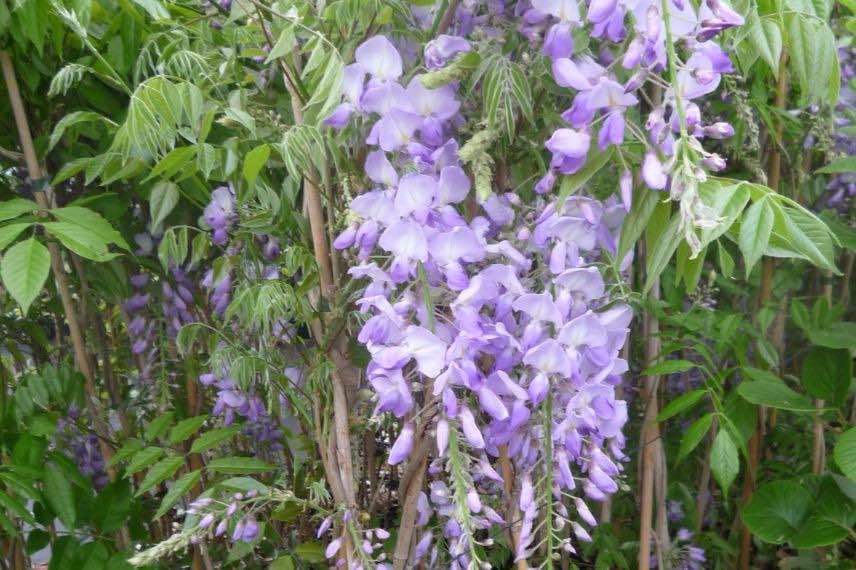
Wisteria sinensis ‘Caroline’
Late Spring Climbers for Pots
You don’t need a large garden to enjoy the benefits of climbers that bloom in late spring. Some modest-sized varieties, measuring less than 2 metres in height, can easily brighten up terraces, balconies, or courtyards.
This is particularly true for the dwarf Australian wisteria Hardenbergia violacea ‘Meema’, which grows to 2 metres in width but only 50 cm in height. Its twining stems will cling to available supports. If none are available, they will spread out to form a ground-covering dome.
Meanwhile, the Clematis x cartmanii ‘Pixie’ delights us with small flowers in white tinged with green. Much more compact and stocky than its relatives, it reaches only 80 cm in height and 60 cm in spread. Being somewhat tender (hardy to -4°C), it will need to be sheltered in most regions. Also of modest size, the Clematis patens ‘Dancing King’ grows to just 1.5 metres in height, making it ideal for container cultivation.
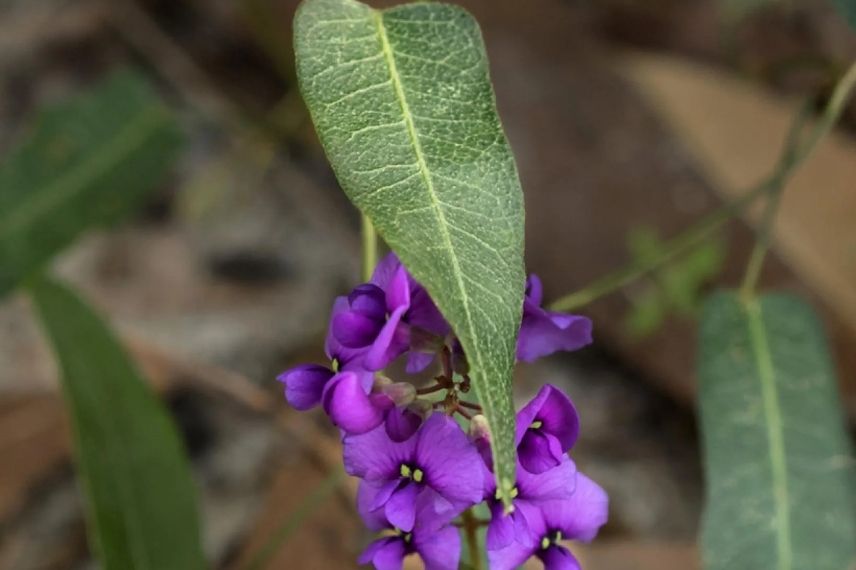
The Hardenbergia violacea ‘Meema’, lesser-known but interesting and compact in size
Evergreen Climbers for Late Spring
Some climbing plants have the advantage of retaining their foliage all year round. They will remain ornamental even in winter and maintain their decorative qualities even after their late spring flowering.
This is the case with the Stauntonia hexaphylla, a still relatively unknown plant, which offers lobed, dark green evergreen foliage reminiscent of that of the horse chestnut. Its spring flowering reveals small cream-white bell-shaped flowers tinged with purple, which are pleasantly fragrant. Hardy down to -9°C, this vigorous vine can be grown in the ground in regions with mild winters. It is a climber that will add a lovely exotic touch.
Let’s mention again the small clematis ‘Pixie’, with its evergreen, finely cut foliage of a beautiful shiny bright green. It will need protection from frost.
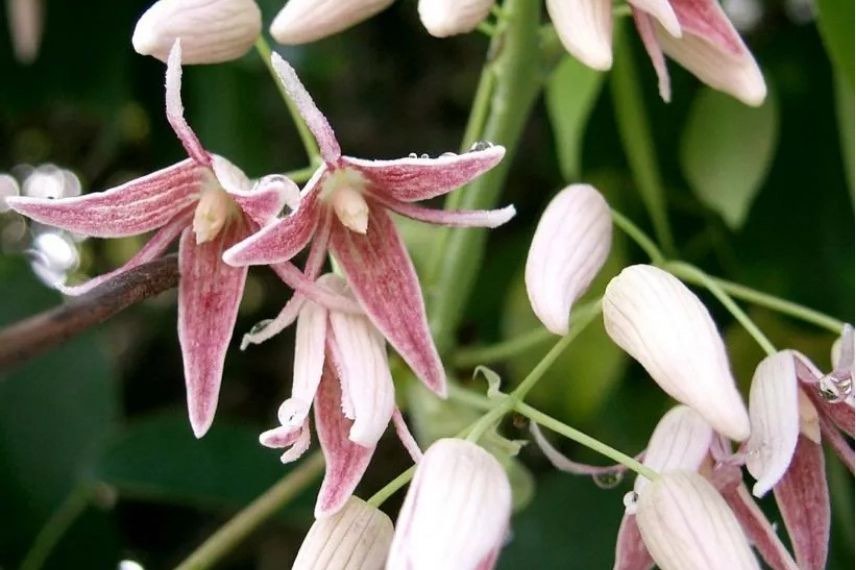
Stauntonia hexaphylla offers evergreen foliage
Here are some tips for a beautiful garden at the end of spring:
In addition to choosing late-flowering climbers, a few simple actions will help you maintain a beautiful garden at the end of spring.
- Don’t neglect watering your plants. In some regions, the end of spring is already quite hot and dry. However, a lack of water can hasten wilting or reduce flowering. For this, it’s ideal to have a rainwater collector, which allows you to make use of the reserves typically gathered during winter and early spring to water your plants.
- Remove faded flowers to stimulate the production of new buds in your perennials, shrubs, and roses. This simple action helps prolong flowering. Perennials can also be pinched to encourage branching and give them a denser appearance: this is the technique known as the “Chelsea Chop”, traditionally carried out in late May.
- Use annuals sown or bought in plugs to fill any gaps in the garden: in flower beds, borders, pots, rockeries, etc.
- Prune the yellowed foliage of certain bulbs.
- Subscribe!
- Contents

































Comments